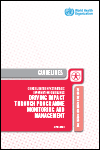Guidelines - Released in 2020
In the health sector response to the HIV epidemic, collection, analysis and use of data are crucial at every level, from patient care and monitoring through programme management and national programme monitoring to global monitoring. This strategic information answers the questions: “How are patients doing?”, “How is the programme performing?” and “How can we do better?” Without these answers, the response to the HIV epidemic would be wandering in the dark.
These guidelines – an update to the World Health Organization’s 2015 publication Consolidated strategic information guidelines – present a set of essential aggregate indicators and guidance on choosing, collecting and systematically analysing strategic information to manage and monitor the national health sector response to HIV.
Specifically, for programme management, these guidelines seek to strengthen programmes’ ability to identify and close gaps in service access, coverage and quality across the HIV services cascade, from primary prevention to knowing one’s HIV status to viral suppression.
For programme monitoring, these guidelines seek to optimize and align national reporting used to assess countries’ progress toward the 2030 95–95–95 HIV Fast Track goals – 95% of HIV-positive people knowing their status; 95% of people who know their HIV-positive status on treatment; and 95% of those on treatment virally suppressed – and towards Sustainable Development Goal 3.3, which calls for ending the HIV epidemic, as indicated by reduced incidence.
Downloads
Organizations
- World Health Organization (WHO)






